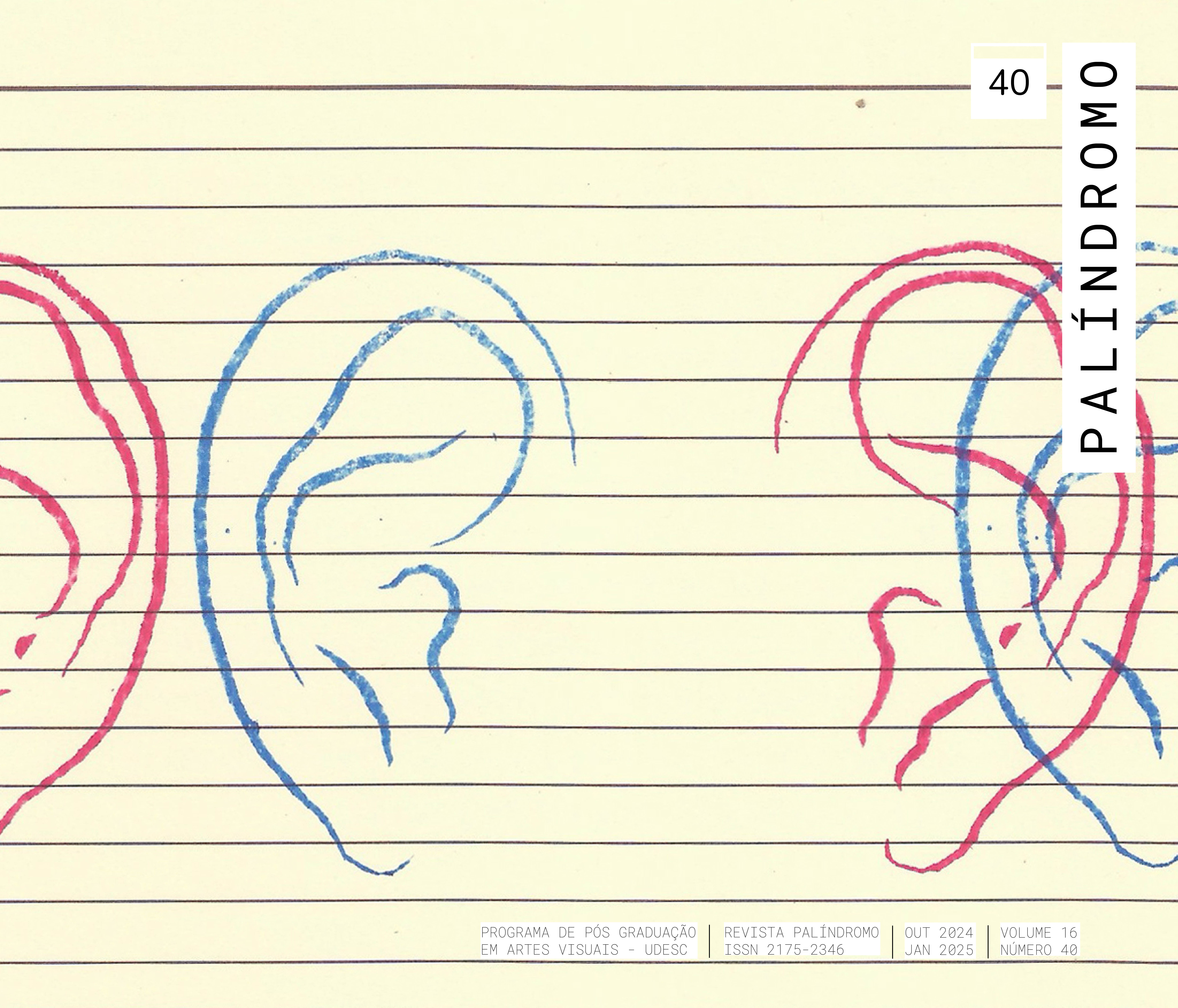A intimidade como imaginação política: o popular na obra de Feliciano Centurión
DOI:
https://doi.org/10.5965/2175234616402024e0015Parole chiave:
Arte contemporânea, Arte têxtil, Artesanato Paraguaio, Cultura Popular, Feliciano CenturiónAbstract
Em um contexto pós-moderno, onde diferentes identidades se entrecruzam, campos ditos opostos se veem em processo de contaminação. Nesse cenário, esta pesquisa visou analisar a posição da obra do artista paraguaio Feliciano Centurión (1962-1996) em intersecções entre dicotomias como o culto e o popular, o hegemônico e o subalterno, o moderno e o tradicional. Para tanto, foram investigadas as adjetivações por vezes atribuídas à obra do artista, como Arte Light, Arte Rosa e Arte Guarango, consequência de seu vínculo com o Centro Cultural Ricardo Rojas, peça fundamental para o contexto artístico de Buenos Aires na década de 1990. Além disso, buscou-se refletir os aspectos simbólicos, políticos e identitários na manipulação de materiais cotidianos e têxteis por parte de Centurión, que explorou a intimidade, o feminino, a temática gay e as tradições têxteis paraguaias, como o Ñanduti e o Ao Po’i. A pesquisa contou também com apreciação da literatura relativa à história da arte, aos estudos culturais e à crítica contemporânea, com enfoque na América Latina e nas diferentes representações do popular. Por fim, pautada nos estudos acerca do hibridismo, esta investigação aponta Centurión como um artista liminar, que entre múltiplas categorias identitárias, abala as limitações do cânone.
Downloads
Riferimenti bibliografici
BARCHELLO, Selva Margarita Olmedo; BÁEZ, Marcela Fernanda Achinelli; ALFONSO, Dahiana Elizabeth Ayala. Asociatividad en las mujeres tejedoras paraguayas en el distrito de Yataity, Guairá, Paraguay. Revista Internacional de Investigación em Ciencias Sociales, Asunción, v.12, n.1, p. 43-60, 2016. Disponível em: <http://revistacientifica.uaa.edu.py/index.php/riics/article/view/312>. Acesso em 28 fev. 2022
CANCLINI, Nestor García. Culturas Híbridas: estratégias para entrar e sair da modernidade. São Paulo: Edusp, 2003.
CENTURIÓN, Feliciano. [Série] Familia. 1990. Conjunto de brinquedos de plástico com crochê. Disponível em: <https://www.ceciliabrunsonprojects.com/artists/79-estate-of-feliciano-centurion/works/1153/> Acesso em 20 de novembro de 2024.
CENTURIÓN, Feliciano. Ciervo. 1994. 1 pintura. Disponível em: <https://millan.art/artistas/feliciano-centurion/> Acesso em 20 de novembro de 2024.
CENTURIÓN, Feliciano. Mi casa es mi templo. 1996. 1 bordado. Disponível em: <https://visualaids.org/artists/feliciano-centurion> Acesso em 20 de novembro de 2024.
CENTURIÓN, Feliciano. Que en nuestras almas no entre el terror. 1992. 1 bordado. Disponível em: oficinapalimpsestus.com.br Acesso em 14 de novembro de 2022.
CENTURIÓN, Feliciano. Paraguay imensamente azul. 1991. 1 pintura com bordado. Disponível em: <https://www.museoreinasofia.es/coleccion/obra/inmensamente-azul> Acesso em 20 de novembro de 2024.
CENTURIÓN, Feliciano. Mundo feminino, [s. d.]. São Paulo: 33ª Bienal de Arte de São Paulo, 2018. Áudio. Disponível em: <http://33.bienal.org.br/pt/audioguia-detalhe/5367>. Acesso em: jan. 2022.
DÍAZ, Susana Trindad Ruiz. El ñandutí, reflejo de dos culturas. UltimaHora, 2021. Disponível em: <https://www.ultimahora.com/el-nanduti-reflejo-dos-culturas-n2947836.html> Acesso em fev. 2022.
ESCOBAR, Ticio. “The strongest thread”. In: IGLESIAS LUKIN, A.; MARTA, K. (orgs.). Feliciano Centurión. Nova York, Americas Society, 2020.
FLEITAS, Jasmín Gómez. La ruta del Ao Po’i. La Nación, 2017. Disponível em: <https://www.lanacion.com.py/revista-vos/2017/12/19/la-ruta-del-ao-poi/> Acesso em fev. 2022
GONTIJO, J. C. A pregnância da forma. MODOS: Revista de História da Arte, Campinas, SP, v. 3, n. 1, p. 268–279, 2019. Disponível em: <https://periodicos.sbu.unicamp.br/ojs/index.php/mod/article/view/8662926>. Acesso em: 8 nov. 2021.
KROCHMALNY, Syd. La Kermesse: arte y política en el Rojas. Revista Caiana, Buenos Aires, v.2, p. 1-15, 2013. Disponível em: <http://hdl.handle.net/11336/28226>. Acesso em 08 nov. 2021.
IGLESIAS LUKIN, A.; MARTA, K. Feliciano Centurión. Nova York, Americas Society, 2020.
LEMUS, Francisco. Arte y vida. Los años noventa en Buenos Aires. Heterotopías, v. 4, n.7, p. 1–25, 2021. Disponível em: <https://revistas.unc.edu.ar/index.php/heterotopias/article/view/33426>. Acesso em 08 nov. 2021.
LEMUS, Francisco. Feliciano Centurión. Fundación MALBA, [s. d.]. Disponível em: < https://coleccion.malba.org.ar/sin-titulo-8/> Acesso em fev. 2022.
QUÉ es el ao po’i qué los trabajadores públicos paraguayos deberán vestirse con ese tejido los viernes?. Actualidad, 2021. Disponível em: <https://actualidad.rt.com/actualidad/413897-ao-poi-trabajadores-publicos-paraguayos> Acesso em fev. 2022.
ROSA, María Laura. Cuando la intimidad es política: arte y homosexualidad en el Centro Cultural Ricardo Rojas de Buenos Aires durante los años ’90. RELASO: Revista Latina de Sociologia, Vol. 5, p. 135-149, 2015. Disponível em: <http://dx.doi.org/10.17979/relaso.2015.5.1.1521>. Acesso em 05 nov. 2021.
SERAFINI, Mariana. Ñanduti, as cores do Paraguai. Vermelho, 2016. Disponível em: <https://vermelho.org.br/2016/01/08/nanduti-as-cores-do-paraguai/> Acesso em fev. 2022.
SILVA, Dayse Centurion; ALVES, Gilberto Luiz. O artesanato Ñanduti em Bella Vista Norte, Paraguai. Espaço Ameríndio, V.14, N. 2, p. 141-159, 2020. Disponível em <https://seer.ufrgs.br/EspacoAmerindio/article/view/106630>. Acesso em 15 fev. 2022.
SOUZA, Laila Rebeca do Amaral; GIUDICE, Rafael Furlan Lo. Artesanato, o espelho do três-lagoense: folkcomunicação, identidade e resistência. In: Anais do XVII Congresso de Ciências da Comunicação na Região Centro-Oeste – Intercom. Campo Grande: Intercom, 2015. Disponível em <https://www.portalintercom.org.br/anais/centrooeste2015/lista_area_IJ01.htm> Acesso em fev. 2022.
Downloads
Pubblicato
Come citare
Fascicolo
Sezione
Licenza
Copyright (c) 2024 Jeanne Drielle Santos Bezerra, Emerson Dionisio Gomes de Oliveira

TQuesto lavoro è fornito con la licenza Creative Commons Attribuzione 4.0 Internazionale.
DECLARAÇÃO DE DIREITOS AUTORAIS
a. Os artigos publicados pela revista são de uso gratuito, destinados a aplicações acadêmicas e não comerciais. Todos os direitos autorais são atribuídos à revista. Os artigos cujos autores são identificados representam a expressão do ponto de vista de seus autores e não a posição oficial da Revista Palíndromo. O (s) autor (es) compromete-se sempre que publicar material referente ao artigo publicado no Palíndromo mencionar esta publicação da seguinte forma:
Este artigo foi publicado originalmente pela revista Palíndromo em seu volume (coloque o volume), número (coloque o número) no ano de (coloque o ano) e pode ser acessado em: http://www.revistas.udesc.br/index.php/palindromo
b. Plágio, em todas as suas formas, constitui um comportamento antiético de publicação e é inaceitável. A revista Palíndromo utiliza o software iThenticate de controle de similaridade


